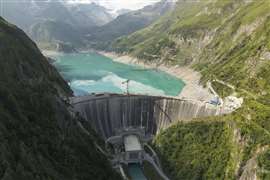Editor's Comment: The Suez Express
11 November 2014

We have become accustomed to major projects moving at a gentle pace. Going from an idea for a piece of infrastructure through the outline planning, consultation, surveying and detailed planning phase can take years. Financing can be a stumbling block and then it is on to contract negotiations and the construction phase.
And despite the best efforts of contractors, delays can occur on major projects due to their complexity and unforeseen problems. It means timescales for projects can run to decades.
So the scheme to increase the capacity of the Suez Canal in Egypt is something of an odd one. The announcement from the Egyptian government that the project was not only conceived, but going ahead came out of the blue in August. This was followed in less than three months by the appointment of contractors to handle some of the civil engineering, with the signing of two dredging contracts worth a total of US$ 2 billion.
The ‘Why?’ of the project is a simple one to answer. With the expansion of the Panama Canal, and rival Atlantic-to-Pacific routes being developed in Guatemala and Nicaragua, the Suez Canal’s position as a link between Asia and the East coast of America was looking under threat due competition from these potentially faster routes.
The plan is for a new channel to be dug alongside about half the length of the existing canal, which would effectively make it a two-way route – the current canal is only wide enough for a single shipping lane parts now.
So the idea and the rationale behind it look sound, but after that the Egyptian government departed from the usual path of such large scale projects. It is not clear whether there has been any environmental impact assessment of the scheme, or how detailed the planning has been. Given how fast things have happened, this aspect of the project looks a bit questionable.
But financing the near US$ 9 billion construction costs looks to have been successful, if unconventional. Such a large project would normally be financed by international institutions. But perhaps mindful of the 1956 Suez Crisis when Israel, France and the UK tried to snatch sovereignty of the canal from Egypt, national ownership seems a crucial issue and only Egyptian entities were allowed to buy the bonds that will finance this new project. Rather impressively, the Egyptian government reportedly achieved its target in just six days.
So far, so good, but now the construction phase is under way, and this looks challenging. The official line is that the new channel will be completed by August next year. With work getting underway in October, that means about a 10 month time line to dig a 73 km new canal. That doesn’t sound like very much time for what is of the order of a 100 million m3 excavation! Granted there are no structures as serious as the Panama Canal’s locks to construct, but it is still a phenomenal civil engineering challenge.
As ever, time will tell if this is an achievable target. There is certainly no lack of ambition on the part of the Egyptian government in terms of the scale of the project and the speed with which they want it done.
STAY CONNECTED


Receive the information you need when you need it through our world-leading magazines, newsletters and daily briefings.
CONNECT WITH THE TEAM











